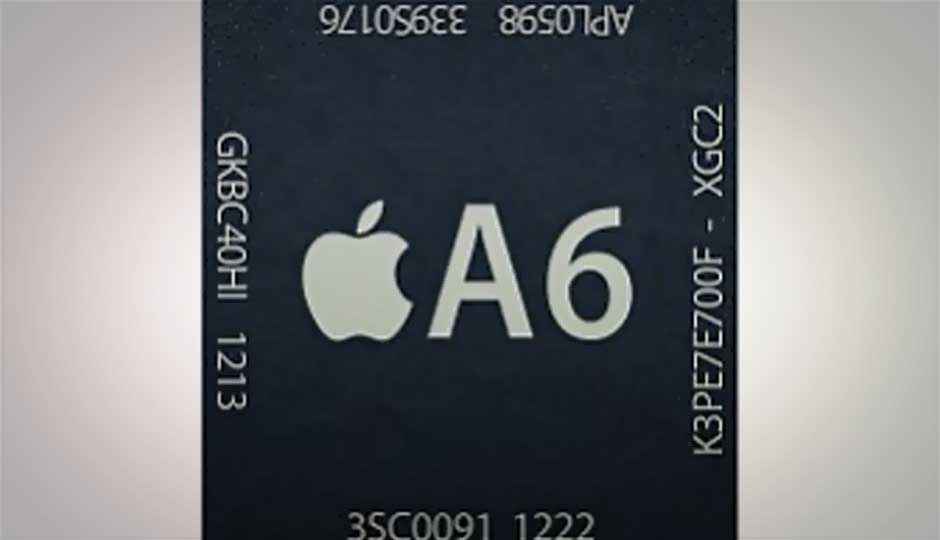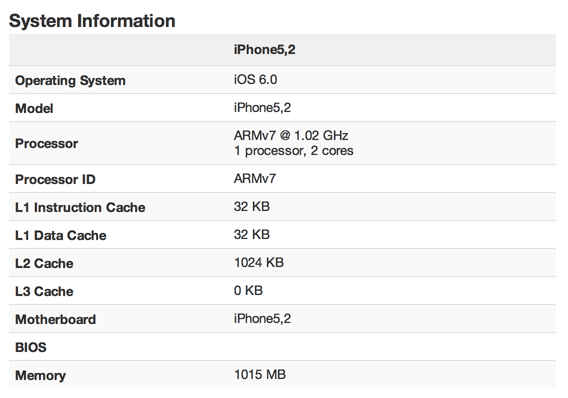iPhone 5 benchmark results show dual-core 1GHz processor and 1GB RAM

Last week Apple announced its sixth generation iPhone called the iPhone 5. At the event Apple claimed that their new A6 processor was twice as fast when compared to the A5 processor powering the iPhone 4S, in terms of both graphics and CPU performance.
 Survey
SurveyPhil Schiller, senior vice president of worldwide marketing at Apple said that the iPhone 5 can launch the Pages apps 2.1x faster, saves images from the iPhoto app 1.7x faster and can view Keynote attachments 1.7x faster when compared to its predecessor.
Apple never gives details about its processor at the launch event, so when the iPhone 5 was unveiled, details of the SoC were unclear, such as the design, clock speeds, type of GPU and memory.
AnandTech has reported that the A6 processor is not based on the latest ARM Cortex A15 design, nor the Cortex A9 design currently used in the A5 chipset. The A6 is the first SoC from Apple to use its own ARMv7 based processor design – Apple’s own creation. Aiding this speculation, are some unconfirmed iPhone 5 Geekbench benchmark results, pointing at a 1.02GHz dual-core two-thread processor, based on the ARMv7 instruction set architecture (ISA) and the 32nm process, coupled with 1GB of RAM.
The Geekbench results also point squarely at what Schiller had announced, roughly 2x the CPU performance. The results also point to a noticeably improved memory interface and cache utilization. Anand Lal Shimpi further speculates A6 chipset will also bear a marginally higher clocked PowerVR SGX 543MP3.
The information or rather “hints” of the new SoC were also present in Xcode 4.5. For those of you that are not familiar, the iPhone 5 launches with Apple’s latest version of its mobile OS, iOS 6. Developers were seeded with the newest version of the development tools for the new OS. AnandTech’s report states, “Xcode 4.5 makes two major changes: it drops support for the ARMv6 ISA (used by the ARM11 core in the iPhone 2G and iPhone 3G), keeps support for ARMv7 (used by modern ARM cores) and it adds support for a new architecture target designed to support the new A6 SoC: armv7s.”
The new processor also supports VFPv4, further eliminating the possibility of higher-clocked Cortex A9-based chipset. Notably, at the press event Apple also announced that the 3GS had lived its life and the entry-level iPhone now is the iPhone 4.
ARM licenses specific processor cores as well as instruction set architectures, which are then licensed out to chip makers who take their own custom features and build the chipsets. Apple is a licensee of ARM, and the easy thing for Apple to do would have been to adopt one of ARM’s cores, like most manufacturers.
By utilizing ARMv7-ISA to customize its own SoC, Apple was able to deliver better performance, whilst delivering better battery life, impossible if it had bumped up the clock speeds (and hence voltage) and power consumption of the Cortex A9 in the iPhone 4S. Apple’s new design is likened by Anandtech to the Snapdragon Krait architecture from Qualcomm, or the Cortex A15 architecture from ARM, probably using the three-wide out-of-order execution that is common to them. Unlike the A15’s higher clock speeds however, Apple would have probably stuck with the less power-hungry Krait-level on its own chipset.
Designing its own SoC also gave Apple the ability to reduce the cost of manufacturing the chipset along with optimizing its performance as per requirement. The fact that Apple has built its own SoC is commendable and when the iPhone is officially available to reviewers, we will know the true potential of the power under the hood.
Source: Anandtech

